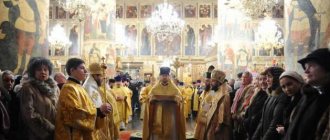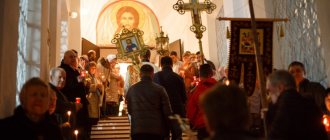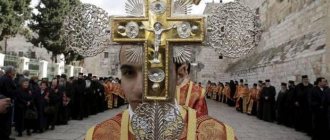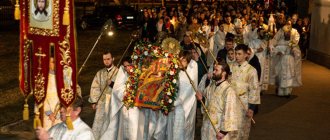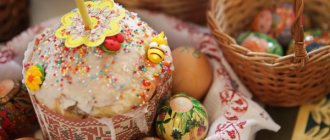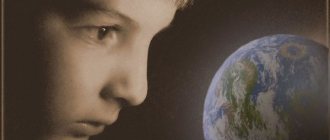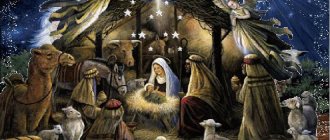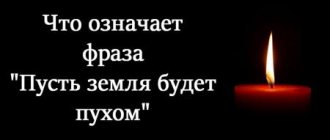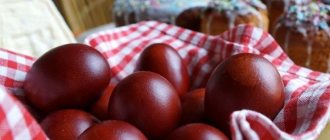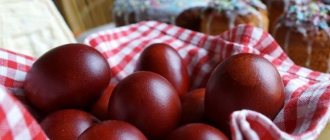The procession of the cross is one of the most iconic and solemn forms of worship. It can be held on Easter or at any other time when believers need the power of common prayer. Such processions are organized both on holidays for Christians and in times of difficult trials. Today, such services accompany all significant events in the lives of believers.
History and traditions of the religious procession
The main difference between the religious procession is its mass character. Tens and even thousands of parishioners take part in the event. The procession is led by a clergyman carrying a large cross - that’s why the procession is called “the cross.” This can be either moving near the temple or a long journey stretching over hundreds of kilometers.
Processions of the cross appeared with the emergence of Christianity. While the bearers of the new teaching were persecuted, open meetings were unpopular. At first, parishioners organized solemn processions only on Easter. When the pressure on Christians stopped, around the 4th century, the tradition spread everywhere, becoming an integral part of worship services.
Reasons for holding religious processions:
- in honor of Christian holidays;
- during the transfer of the relics of saints or other shrines;
- in case of natural disasters, wars and epidemics.
It was with the religious procession to the Dnieper (river) that the history of Christianity in Rus' began - during this service the baptism of the people of Kiev took place.
Once upon a time, a procession of the cross was used to describe the exclusively pedestrian movement of believers led by priests. But scientific and technological progress has made adjustments not only to secular, but also to religious life. Today it is not at all necessary to walk to worship. Thus, with the blessing of the clergy, aerial or flying religious processions can be held.
On a note! During the Great Patriotic War, by agreement between the leadership of the USSR and the clergy, a flight over the capital was made with the miraculous icon of the Mother of God. Moscow, despite all the might of the Hitlerite machine, was defended.
In 2009, with the blessing of Patriarch Kirill, the religious procession burst into space. Thanks to the Orthodox Expedition, the miraculous icon, together with the Soyuz TMA-16 spacecraft, orbited the planet 176 times. No matter how the service is performed, on foot or in spacecraft, on earth or in the air, it spreads and strengthens faith, protects from harm and glorifies Christ.
Among the liturgical features, the following should be highlighted:
Each service before the Ascension of the Lord begins with three times of singing or reading the Easter troparion “Christ is Risen from the Dead...”
Easter before the Ascension, the Easter canon and Easter stichera are read.
On Friday of Bright Week and Wednesday of the Fourth Week the water is blessed
Special commemoration of the dead takes place on Tuesday of the Second Week and on the Saturday before Pentecost.
All services of Bright Week take place with the Royal Doors open.
After each Liturgy on Bright Week, a religious procession is held.
On Saturday of Bright Week the Easter Artos is broken up and distributed to believers
How does the Easter procession take place?
Festive services begin on Holy Saturday at 8 pm. You must wait until midnight to see the procession. The service is held in the church, in semi-darkness, by candlelight. Even those who do not consider themselves believers watch with interest the ceremony accompanying the great holiday of the Resurrection.
The main difference between Easter services is their solemnity. Temples are filled with a special atmosphere, you can feel the approach of the holiday, which for millions of Christians is the moment of truth.
Before Easter there is a religious procession. It is organized on the day of the Holy Resurrection of Christ, and since ancient times symbolizes the desire of Christianity to go to the Savior. In addition, believers who follow the priests put another meaning into it: the procession is the path to the Light, which Christ showed to people wandering in the dark.
Order of ceremony
The Easter procession does not last long, but it is decorated very solemnly. Every believer strives to take part in this festive event that glorifies Christ.
About Easter Hours and Liturgy
In many churches, the hours and Liturgy immediately follow the end of Matins. The Easter hours are read not only in church - they are usually read throughout the entire Easter week instead of morning and evening prayers.
During the singing of the hours before the Liturgy, the deacon with the deacon's candle performs the usual censing of the altar and the entire church.
If in a church the Divine service is performed conciliarly, that is, by several priests, then the Gospel is read in different languages: in Slavic, Russian, as well as in the ancient languages in which the apostolic preaching was spread - in Greek, Latin, and in the languages of the peoples most known in a given region. terrain.
During the reading of the Gospel in the bell tower, the so-called “enumeration” is performed, that is, all the bells are struck once, starting from the small ones.
The custom of giving each other colored eggs for Easter dates back to the 1st century AD. Church tradition says that in those days it was customary to bring him a gift when visiting the emperor. And when the poor disciple of Christ, Saint Mary Magdalene came to Rome to Emperor Tiberius preaching the faith, she gave Tiberius a simple chicken egg.
Tiberius did not believe Mary’s story about the Resurrection of Christ and exclaimed: “How can someone rise from the dead? This is as impossible as if this egg suddenly turned red.” Immediately before the eyes of the emperor, a miracle happened - the egg turned red, testifying to the truth of the Christian faith.
How is the service going?
The Easter service is especially solemn, as it is held on the biggest Christian holiday. Throughout the saving night preceding the Resurrection, believers remain awake. In the evening, the Acts of the Holy Apostles are read in churches, then they move on to the Midnight Office.
Start of service
Those who plan to stay up all night on Easter must come to the temple before midnight. There is a service in the churches at this time. She is called the "midnight office."
During the service, the priest and deacon approach the Shroud and burn incense around it. This is the name given to burning incense, symbolizing the presence of Christ and the prayers offered to him. It is often said that incense is a fragrant sacrifice to God.
While performing the ritual, the clergy sing “I will arise and be glorified.” Next, they take the Shroud and carry it to the altar. All the priests stand at the Throne, candles are lit in the temple. At 12 o'clock at night they begin to sing a stichera about the resurrection of Christ. They sing it louder and louder, when the gates open, the stichera is sung at the top of their voice.
Service during the procession
When the procession stops in front of the locked doors, the rector of the temple takes the censer from the deacon and burns incense. The priests sing three times about the resurrection of Christ. Then they sing the surplices, ending each with the troparion “Christ is Risen.”
Having chanted “Christ is risen from the dead, trampling down death by death, and giving life to those in the tombs,” the clergy enter the opened doors. The church service lasts about three hours. This should be taken into account by those who are planning to come to the Easter service with children. When the procession ends, Matins and the Divine Liturgy begin in the church.
From Easter to Ascension with children
Photo: Tatyana Chubenko
Easter night. An all-celebratory and saving, radiant night. Procession. Each child has his own glass lantern. "Christ is Risen!" - in front of the open doors of the temple. Easter Liturgy. Excited, happy, nodding, but singing along with the choir children... Communion. The first colored eggs. At home - Easter cakes, Easter, breaking the fast... New day, new life. Holidays holiday, red Easter! What a blessing that we are Orthodox, that we are in the Church, that we can become partakers of this miracle!
Easter in our house means that before meals we sing the troparion “Christ is Risen from the Dead” today, throughout Bright Week, and all other Easter weeks, until the Feast of the Ascension of the Lord.
Easter in our house is a special decoration of the house: red towels on the icons, the letters “ХВ” at the home iconostasis, Easter cards and drawings on the walls, our living Easter tree decorated with eggs.
Easter in our house also means special food. Which tangibly distinguishes Easter days from the series of days of the whole year. Every morning begins with a colored egg. Easter cakes and cottage cheese - throughout Bright Week.
Throughout Great Lent, throughout Holy Week, we prepared for the celebration of the Resurrection of Christ. And so we met this holy night. But there is still a day ahead. There is still Bright Week ahead. There are still 39 Easter days ahead. And we would like our children to live all this time in Easter joy, in memory of what these days are dedicated to.
Easter Sunday evening
On the evening of Easter Sunday we are going to Easter Vespers. It is very short and absolutely amazing, almost entirely consisting of Easter chants. We usually go to the center so that we can walk around the historical part of the city. We often choose the Kremlin for such walks. One day we walked through the Kremlin cathedrals with our children and my sisters, and in each church we quietly sang the Easter troparion in front of the ancient altars. We managed to do this unnoticed. But in one of the cathedrals we were “spotted” and promised to be expelled for violating the silence of the museum... Eh, the wild Saprykins didn’t end up on TV as museum desecrators!
Don’t sit at home, don’t go on a visit – but go to where our Orthodox culture and our history are
Or we also visit monasteries. In Sretenskoye you can go down into the Cave of the Holy Sepulcher, quiet, mysterious, as if it were the very same one. The Cave of the Holy Sepulcher is also in the restored New Jerusalem Monastery. In Donskoy you can walk through the famous necropolis and sit in front of huge marble bas-reliefs salvaged from the bombed Cathedral of Christ the Savior. We try to go to a place where we don’t go often, where the children themselves ask. Not to sit at home, not to go on a visit - but to come here, where our Russian Orthodox culture and our native history are. And - Easter, Easter all around!
Easter hours
Throughout Bright Week, instead of morning and evening prayers, we, like our entire Church, sing Easter hours. So that we can sing these Easter chants all together, the children take prayer books in their hands. “Even to the grave”, “Preparing the morning”, “Like the Life-Bearer” - we write out one of these chants in large letters, in Church Slavonic, on a thick sheet of paper, and we hang the beautifully designed text near the icons: you can also peep during prayer. “Lord, have mercy” must be read 40 times in a sequence of hours - we distribute this number in advance to all our children who are able to both repeat the prayer and count correctly. This choral singing and reading in turn helps all children participate in common prayer. And the very singing of the clock every day gives us Easter joy.
Liturgy and bell ringing
It’s good when May 1 or 9 falls on these holy days - but such happiness does not happen often. We don’t have weekends like Easter Monday, like in the “rotten” West, and Easter Monday is an ordinary working day in our country. But taking advantage of the fact that you can skip school for up to three days without a doctor’s certificate, our children do not study at least on the first day of Bright Week. But we still get up early because we are going to church.
The liturgy on Svetlaya is special, with the royal doors open. And the children are interested to see what happens in the altar
The liturgy on Svetlaya is completely special. There are usually very few people, the churches are almost empty. The service is short, the children do not have time to get tired. The service on the first Easter week takes place with the royal doors open, and the older children approach the altar itself: those moments of the service that we usually do not see can now be clearly seen. Children especially love to watch the clergy receive communion in the altar - this can only be seen these days. We definitely take communion, in general we try to take communion as often as possible these days. And after the Liturgy, every day this week there is a religious procession. Since there are few people, older children are sometimes asked to carry icons and even banners.
Ringing the bells is one of the most anticipated miracles of Bright Week for children
Throughout Bright Week, according to tradition, in almost all churches you can go up to the bell tower and ring the bells, most often just after the Liturgy and procession of the cross, or in accordance with a special schedule for such ringings. And this is one of the most anticipated miracles of Bright Week for children. For small children, to be completely happy, it is enough to just pull the strings once and in response hear the discordant ringing of bells above their heads. But the elders like to ring wisely, in order, and agree with each other in advance who will take which bell, what the rhythm will be. True, due to the lack of experience, even students and graduates of a music school end up with a very pathetic chime. But there is a desire to learn, improve and, of course, become a bell-ringer “when I grow up.”
Russian Easter games
Each holiday is, first of all, its content, meaning, spiritual component. But these are also the traditions that have grown up around this holiday for centuries, distinguishing it from the series of other days. The importance of such traditions becomes obvious when we begin to celebrate a particular holiday with children.
The children have returned from the temple. Let's eat. Of course, we prayed... But what next? Is it day like day, but there is no school? Looking out the window, playing with ordinary toys, watching cartoons - is this a holiday? It's just a day off...
For a day to be special, the whole way of life must be special. Prayer, reading - this is the spirit, this is the word. And children also need to add something mental and physical. Edible, visible, tangible.
Folk traditions help to distinguish holidays from a series of everyday life
And here the traditions of our people come to the rescue, the traditions of people who, over many generations, were born, grew up, rejoiced and mourned in the context of Orthodox culture. Often folk traditions have no sublime and spiritual meaning at all. But there is a feeling of Holiday. And by indirect reminder of the holiday or by their very unusualness, unusualness, these traditions help to distinguish holidays from a series of everyday life.
And here are some of the Russian folk traditions that enjoy great success in our family and in the families of our friends.
Classics of the genre - egg battles. Each child has a boiled colored chicken egg in his hand. Everyone takes turns fighting each other: hitting one egg against another. The one whose egg remains intact wins. It is convenient to organize such a battle before eating, when a broken egg can be immediately peeled and eaten.
In the first days after fasting, it is better to limit the number of eggs eaten per day. And that’s why we organize only one such battle a day, and this happens before breakfast, after returning from the temple. And if guests are expected, then in the morning the children eat one small quail egg and then, together with the guests, fight on large chicken eggs and, accordingly, they are eaten.
Another Easter game is egg rolling. To do this you need a slide and wooden eggs of the same size. These slides are available for sale. Or you can do it yourself. To do this you need a board or plywood with sides. You can also come up with a “disposable” slide - made of folded cardboard. Some use real slides for children to ride.
There are many variations of this game. For example, this one. Each child receives a wooden egg. Around the slide, at a distance of 20–40 cm from the descent, depending on the steepness and size of the slope, the remaining eggs are laid out, two to three times more than the number of participants in the game. Players take turns rolling up their testicles. The egg rolls slowly along an unpredictable trajectory. If your testicle hits one of the slides laid out around you, you take that testicle for yourself. Thus, there are fewer and fewer eggs around the slide, and each player ends up with several eggs in his pockets. The one who gets the most testicles wins.
Or here's another option. It’s not eggs that are laid out around the slide, but small surprises and souvenirs. It is important that these prizes are fairly equal. Players take turns rolling their testicles. If your testicle touches any surprise, you take it for yourself. To avoid a situation where one player received a lot of prizes and the other received nothing at all, each player rolls up his testicle until the gift is received. With this game you can give gifts to your children and friends' children for Easter.
Traditions include, of course, the already mentioned, beloved Easter cakes and curd Easter cakes that survived the deepest Soviet times. This is an edible tradition that reminds us of the Holiday every day, both visually and deliciously. And in the vast expanses of our vast empire, there was a custom of “talking around” - going from house to house and singing songs, something like Easter carols. If you don’t sing yourself, then you can at least listen to such songs, and maybe sing something to friends and guests.
Easter weeks
Easter decoration of the choros of the Sretensky Monastery. Photo: A. Pospelov / Pravoslavie.Ru
Every Sunday after Easter is dedicated to some gospel event. Antipascha, also known as “the second week after Easter, O Thomas,” recalls the appearance of Christ to the disciples after the Resurrection. As always in such cases, we read the Gospel with the children, which tells about the corresponding event, look at illustrations, icons that show “The Assurance of Thomas.” The next week, the third, is about the myrrh-bearing women, and we are also preparing children for the celebration of this holiday, for the Gospel reading in church. The fourth week is “about the paralytic,” and we remember with the children this meeting of Christ and the man who waited for many years for the “movement of the water” at the Sheep Pool. The fifth week is “about the Samaritan woman,” about the teachings of Christ as living water, which he who drinks will never thirst. Then - the last Easter week, “about the blind man.” And we read about this again, we find images of this miracle - the miracle of the healing of a man born blind.
Thus, during all Easter weeks, we not only continue the celebration of Easter, but also turn to the Gospel and study it. All together, with our entire home, we listen to the events that our Church offers us for instruction in these bright days.
Easter Traditions Around the Universe
Usually Bright Week passes and the peculiarity of Easter days somehow disappears from our lives. Children have school, with preparation for final tests, tests, and exams. Parents have work... But the holiday of Christ’s Resurrection continues, and I would like not to forget about this in the bustle of everyday work.
Children are constantly inventing something, making things, drawing. Often - freely following your unlimited imagination. But sometimes we direct this fantasy, especially if the child asks for help with ideas. And here we try to suggest to children such stories that will again and again remind us of the ongoing Holiday, and even better, teach us something. For example, we made original illustrations for the Easter canon. “From the grave of the red truth the Sun rose for us” - this phrase is easy to depict in paints or in appliqué. My children drew a coffin, like they are on icons, and from this coffin comes a huge shining red sun. The phrase from the canon is necessarily written at the bottom of this image. In this way, children become familiar with the deep images of worship, remember them, and generally begin to imagine the service filled with many images and meanings. This means that they are learning more and more about Orthodox teaching, which means they are getting closer to education, real education...
On weekends you can continue to visit monasteries, museums, preserved and restored Russian estates. Sometimes you manage to get to street Easter concerts - this format suggests the possibility of children’s delight or, conversely, dissatisfaction, and you can also leave the high-profile meeting at any time unnoticed.
What about at home? It is impossible to endlessly fight on eggs - and one day the colored eggs will run out. Still, you can’t eat these foods for the entire six weeks. You should also not roll wooden testicles for a month and a half. And this is what we came up with. It turns out that our first Easter week is completely special - it includes divine services, the ringing of bells, and Russian traditions. But we dedicated each subsequent Easter week to the traditions of some other people. For example, Greece is a country in which Orthodox traditions also have their own centuries-old history. We've run out of Easter cakes and Easter cakes - and we're preparing traditional Greek Easter dishes. This is “tsureki” - a bun in the shape of a pigtail, with a boiled colored egg placed in the middle (we paint three or four of them again) - the bun is baked directly with the red egg. The children themselves looked for recipes on the Internet and baked this delicious thing. We also prepare the soup with which the Greeks break their fast on Easter night. A hearty and at the same time light dish - lamb giblet soup, migaritsa. And at the same time we are looking for recipes for other traditional Greek dishes, and throughout the week we have something like a “week of Greek cuisine.” How do Greeks spend Holy Week? How do you celebrate Easter itself? What kind of religious processions do they have? We find all this on the Internet, look at photos and videos. And all this turns out to be more than just entertainment.
An appeal to another Orthodox tradition shows: traditions are a conditional thing, but the main thing that unites us is our Church
Such an appeal to another Orthodox tradition shows our children that these very traditions are a conditional thing. It is not Easter cakes or cottage cheese that make a holiday a holiday. And our Russian folk customs - dear to us, beloved, revered and carefully preserved - are just customs, without which the same Orthodox Greeks can easily do without. But what we have in common is the most important thing: our Church, the Gospel, the teaching of the saints and the joy with which the glorious Orthodox faith fills us.
And also for the “week of Greek Easter” we write the inscriptions “Χριστός ανέστη” and the response “Αληθώς ανέστη”. We congratulate each other all week with exactly these words. We also write the entire Easter troparion in Greek. And at the same time, we learn or repeat Greek letters, reading rules, and in general we continue to get used to the graphics of Greek words, we overcome the fear of this difficult language - the language of ecumenical teachers and saints, the language of Orthodox theology.
My children were very impressed by the traditions of the island of Kerkyra (Corfu). What is it worth to throw clay jugs from windows on Holy Saturday! Of course, the children immediately came up with the idea of throwing a couple of flower pots from the balcony. Cruel parents forbade repeating this tradition anywhere except Kerkyra itself. The impression of the holiday is perfectly conveyed by videos about Easter in Corfu. These are incredibly colorful crowded religious processions, with brass bands and fireworks. The children are amazed: is this really the whole city Orthodox?!
Turning to Serbian traditions, among other things, we listened and sang Serbian songs together. By heart - our favorite “Christ is Risen, Bringing Joy” to the verses of St. Nicholas of Serbia. This is how, little by little, we get to know the Orthodox peoples and the richness of the culture of these native countries.
And then there are the non-Orthodox, but still certainly Christian cultures of the “West”. One of the Easter weeks turned out to be very interesting, during which we studied English Easter traditions. We learned about the English tradition of hiding Easter eggs in the garden with surprises for children - and we hid such eggs in the garden at the dacha. The children prepare a colorful inscription “Christ is risen!”, and we congratulate each other on the Resurrection of Christ in the language that our children learn at school, at home and in courses. We bake Easter hot cross buns, learn Easter songs in English - and at the same time repeat and master the vocabulary of the most popular language in the world. This is how we “pass” other countries. By the time of Easter, our entire house is covered in Easter inscriptions in different languages, familiar and unfamiliar. But we know that in all these languages people glorify the resurrection of the Savior. During the Easter weeks, we have time to try Italian pastiera, Spanish Mona de Pascua, and learn about the life of many, many countries on our planet. The material is more than enough for several years.
It is very important for children to learn and realize that the whole world is filled with Orthodox churches
Turning to the culture of “non-Orthodox” countries, we first of all necessarily learn that initially these countries were still Orthodox, that they were enlightened by the first disciples of Christ. We find information on the Internet about Orthodox communities in England, France, and the USA. And this turns out to be very important for children - to learn and realize that the whole world, the whole universe is filled with Orthodox churches. Everywhere, in every country, there are people who today, together with us, with the same words, in the same worship service, albeit in other languages, glorify our Savior. And the same England and America, which are “from textbooks”, which are “from magazines and films”, which are from all kinds of advertisements, can also be Orthodox, the same as us, the same as our saints were, the same what were the first Christians like...
And so, with “merry feet” we gradually reach the day of Easter. And all this time we continued to rejoice in the Resurrection of the Savior; all this time there was a feeling of celebration in our house. This turns out to be a time of education - true education, education as entry into the world of the Church, as communion with the teachings of Christ.
And this was a time of education and training. Cultural studies and geography, history and art... Moreover, we not only found the same Greece, the same Bulgaria on the world map, we didn’t just read something - but we got to know these peoples and even “lived” a little in their culture. And such an acquaintance is a memory for a lifetime.
And such events are not just “lessons” or a form of leisure for children, but they are an opportunity for everyone – both children and parents – to be together. Invent something together, study together, play together, read together, cook together - and rejoice and celebrate. Celebrate as only children can... Celebrate the greatest holiday, “with the world visible and invisible,” celebrate “with all creation” the killing of death, the enlightenment of the universe, the rebellion of Christ, eternal joy.
